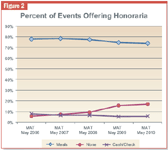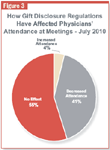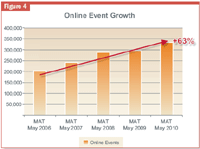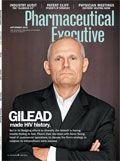Tracking Meetings in Troubled Times
Scrutiny of pharmaceutical promotion and gifts to practitioners has intensified, with more states enacting reporting requirements. In May, the federal government passed the Physician Payment Sunshine Act. What kind of impact is all this having on meetings and physician attendance?
Meetings and events have been an integral part of drug companies' overall promotional strategy for years, according to SDI, a healthcare analytic organization that has been tracking them since the early 1990s.
And irrespective of the jumble of challenges facing the industry—increased regulatory scrutiny of industry promotion, healthcare reform, mega-mergers, smaller field sales forces, and a stalled economy—such events remain a key marketing practice for the industry.
Of the almost $21 billion spent on practitioner details, events, direct-to-consumer advertising, professional journal advertising, and online promotion during the 12 months ended May 2010, nearly $3 billion, representing 14 percent of all promotional expenditures, was for in-person meetings and events.
Most events are truly promotional and do not offer continuing medical education (CME) credits (91 percent in the year ended May 2010). Even with some companies, such as Pfizer, pulling back and not sponsoring CME events, the percentage of events that offer CME credits has held constant over the last five years (at 9 percent to 10 percent).
The meetings tracked here are solely promotional activity and exclude any events that offer CME credits. Also note: In the case of mergers and acquisitions, current-year information is compared with combined legacy company activity. For example, information contained in the article about Pfizer includes all Wyeth brands.
Overall Trend
During the year ended May 2010, the pharmaceutical industry sponsored nearly a half-million events, 6 percent fewer than the previous 12-month period.
What's interesting, however, is irrespective of market and industry pressures, the number of physicians at events (2.4 million) only declined 1 percent from the previous year. The average number of physicians per event was 4.8, up from 4.6 the prior year.
The vast majority of events (86 percent) are what we consider small group or small rep meetings. This means they include a limited number of physicians (generally fewer than 10), a facilitator or sales representative to lead the meeting, and they take place in person.
Teleconferences and videoconferences were the second-most popular type of event, accounting for 6 percent.
The physicians attending events were most often primary care doctors, accounting for 48 percent of attendees. Pediatricians, psychiatrists, and cardiologists were also popular meeting participants.
Significant growth in the number of events for cardiologists and the number of cardiologist attendees was in large part due to product launches, including Eli Lilly's Effient.
Top Promoters: Merck and GSK
Merck and GlaxoSmithKline were the leading sponsors of meetings and events in the 12 months ended May 2010, with each holding about 41,000 (see Figure 1).

Figure 1
Merck's events most often promoted Singulair, which was the subject of 20 percent of the company's meetings. Januvia and Gardasil were the second- and third-most promoted products by Merck.
The number of GSK meetings in the 12 months ended May 2010 rose 10 percent from the prior year, with events for each of the company's top products increasing significantly. GSK's meetings for Advair Diskus, Lovaza, and Avodart rose 56 percent, 29 percent, and 102 percent, respectively, from the year before.
Pfizer, AstraZeneca, and Forest rounded out the top five meeting sponsors. Although Forest ranked fifth in total events, its hypertension brand Bystolic led the industry with 12,015 events in the 12 months ended May 2010.
Top Therapies: Hypertension and Diabetes
Hypertension drugs, including Bystolic, and diabetes therapies led all categories in event promotion. Events supporting hypertension products decreased almost 32 percent in the year ended May 2010, with significant declines in the volume of Novartis' Tekturna and Exforge meetings.
Events for diabetes brands climbed 21 percent from the prior year, boosted by increased promotion of Byetta by Amylin and Eli Lilly (up 37 percent) and the recently launched Onglyza, and marketed by Bristol-Myers Squibb and AstraZeneca.
Impact of Gift-Disclosure Legislation
Over the last few years, scrutiny of pharmaceutical promotion and gifts to practitioners has intensified; in response, some states have required the reporting of physician gifts from drug and medical device companies. In addition, the Physician Payment Sunshine Act was passed as part of the larger healthcare reform legislation in May 2010. The Sunshine Act requires pharmaceutical and medical device manufacturers to disclose payments made to physicians. While the federal law does not supersede existing state laws, it requires disclosure of individual payments of $10 or more or aggregate payments to a physician of $100 or more in a given year. This disclosure is made to the Department of Health and Human Services, with the names of companies and physicians posted on a public website.
Currently six states have gift-disclosure laws, with the minimum reporting value ranging from $10 to $100. The 2009-2010 legislative sessions saw 11 additional states propose laws or regulations relating to gift disclosure or bans. In response to the pending legislation and reality of public disclosure of this information, both the American Medical Association and the Pharmaceutical Research and Manufacturers of America (PhRMA) have instituted voluntary guidelines advising physicians not to accept, and companies not to provide, gifts in excess of $100, and that all gifts should be educational.
Historically, it wasn't uncommon for physicians (and in some cases their families) to be taken to luxurious meeting places and restaurants for events as well as receive gifts for their attendance. When PhRMA issued gift-giving guidelines in the early 2000s, major shifts in honoraria and event locations took place. Subsequently, there have been some noticeable changes in the characteristics of events and physician participation.

Figure 2: Percent of Events Offering Honoraria
The percentage of events where no honorarium/incentive was offered increased from about 5 percent in the 12 months ended May 2006 to more than 20 percent in the 12 months ended May 2010. Even presentation of meals/food declined from 77 percent to 66 percent of events over the same period (see Figure 2).

Figure 3: How Gift Disclosure Regulations Have Affected Physicians’ Attendance at Meetings â July 2010
So, how do these new regulations affect doctors? In a recent SDI poll of 300 physicians, more than half reported that there has been no change in their event attendance, while 40 percent reported that they have decreased their attendance as a result of gift-disclosure regulations (see Figure 4).

Figure 4: Online Event Growth
With the hurdles imposed by gift-giving restrictions, along with the stormy economic climate, pharmaceutical companies increasingly have turned to a more cost-effective approach: online events (see sidebar). Expect the industry to continue to adapt, as the impact of healthcare reform grows clearer.

Online Events Growing
Who's Sponsoring Online Then?
Interestingly, the top sponsors of online meetings differ from those supporting in-person events. In the 12 months ended May 2010, Pfizer held the most online events, followed by Merck, Shire, GlaxoSmithKline, and Forest. Pfizer has dramatically increased its focus in this area over the last few years. Compared with the 12 months ended May 2009, Pfizer online events rose 60 percent.
Merck has been one of the trailblazers in e-promotion over the last few years but has decreased its participation in the most recent 12 months. Online events sponsored by Merck fell 22 percent in the year ended May 2010. Shire, GlaxoSmithKline, and Forest all increased their e-promotion activity with 35 percent, 6 percent, and 68 percent more online events, respectively, in the 12 months ended May 2010.
The most-promoted pro- duct online was Merck's Singulair, with just over 13,000 events. Shire's Vyvanse followed with almost 12,000. Pfizer's Pristiq, Merck's Januvia, and Pfizer's Celebrex completed the top five drugs promoted through online events.
Kelly Sborlini is Vice President, SDI, Audits & Media Innovations. She can be reached at ksborlini@sdihealth.com

The Misinformation Maze: Navigating Public Health in the Digital Age
March 11th 2025Jennifer Butler, chief commercial officer of Pleio, discusses misinformation's threat to public health, where patients are turning for trustworthy health information, the industry's pivot to peer-to-patient strategies to educate patients, and more.
Navigating Distrust: Pharma in the Age of Social Media
February 18th 2025Ian Baer, Founder and CEO of Sooth, discusses how the growing distrust in social media will impact industry marketing strategies and the relationships between pharmaceutical companies and the patients they aim to serve. He also explains dark social, how to combat misinformation, closing the trust gap, and more.